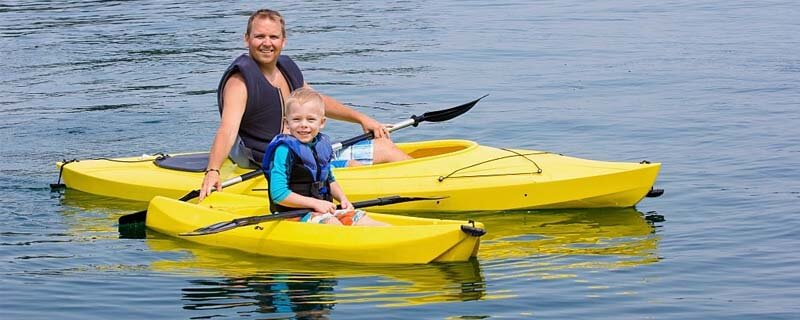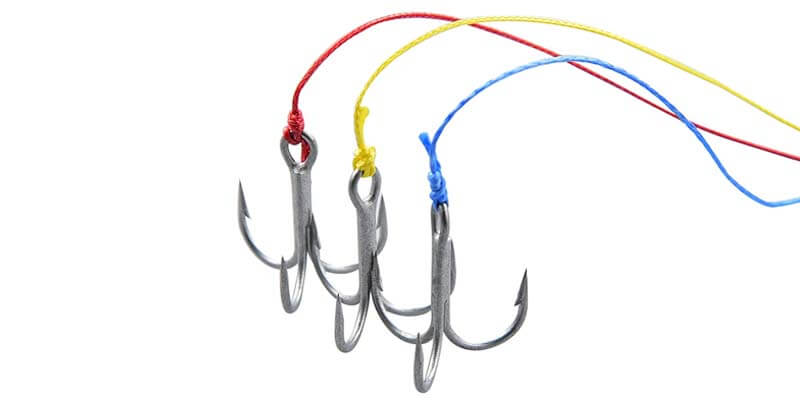When it comes to Kayak vs. Canoe, both terms are often used interchangeably, but they do not mean the same thing. For people who know the difference between a kayak and a canoe, it is often difficult for them to choose which is better. The reason is they are suited for a wide range of water conditions. Hence, selecting either of them depends on your fishing needs.
What Is a Kayak?

A kayak is a vessel that is propelled with a double-blade paddle. Typically, a kayak comes with a deck covering and more than one cockpit. Sometimes, the deck covers the cockpit, which prevents water from seeping into the vessel. The spray deck’s presence makes it easy for the kayaker to paddle and balance the kayak, thereby preventing capsizing.
What Is a Canoe?
A canoe is a vessel that comes with an open top and pointed ends. A Canoe is driven with paddlers that typically face the traveling direction. Canoes come with seats that are similar to small benches. Hence, when you sit in a canoe, your posterior is at the same level or beneath the hull’s edge. At the same time, your feet are positioned as if you are sitting in a chair.
Also Read: Best Trolling Motor – Extensive Reviews
Kayak vs Canoe: 6 Differences to Help You Choose
Because not everyone knows how to differentiate a kayak from a canoe, here are some differences in this kayak vs. canoe fishing guide that would help you set them apart. More so, knowing these differences would go a long way when you want to buy either of them.
Closed vs Open Design
The primary difference between Kayak vs Canoe is their design. Kayaks have a smaller size, and they are sleek. They are structured for recreational purposes and for those who love to speed on the water. In comparison, Canoes are heavier and more spacious than kayaks. They have a broad frame and an open-top that looks like a rowboat.
Canoes are designed to carry several people and more stuff. Also, Canoes come with tall sides, and they have a higher sitting stance on the water than their counterparts. It is essential to mention that some Kayaks come with open-top like Canoes, but they are not popular.
When it comes to versatility, kayaks earn the berth as they are suited for various needs. Today’s canoes and kayaks have excellent stability on the water, and they are made with durable materials like fiberglass, plastic, and wood.
Comfort and Seating
Because a canoe comes with an open-top design, you can enter and leave quickly, unlike the kayak. It is just like coming onboard without any stress and going seamlessly anytime you want to. For stability, you use the sides of the canoe fishing vessel or a dock to balance yourself, and when you are inside, you stand up. In comparison, it is not easy to get into a Kayak.
The paddler needs to spread their legs in the cockpit and maintain balance so that the boat does not tip. However, when you are inside, the advantage of being in a Kayak is the snug feeling it gives. Generally, it is easier to control a kayak than a canoe. Also, a Kayak cockpit typically comes with back support, which is excellent for people who would be spending more than a day at sea.
For a canoe, you will get tired of sitting erect without any support for your back. The only point a canoe offers comfort is the freedom of movement provided by its open-top design. The Kayak paddler is restricted to the cockpit, while the canoe paddler has the luxury of moving anytime.
Method of Paddling

Even though a canoe is more comfortable than a kayak, in terms of paddling, the kayak offers greater ease of use. Canoes are heavier and bulkier than kayaks. Hence, they require more effort in paddling. Usually, if you want to paddle a canoe, it is difficult to do it alone. This is why you would often see two or more people paddling a canoe.
It is crucial to mention that when learning either to paddle a canoe or a kayak, it is generally difficult to master the canoe’s basics. The paddles of a Kayak come with a blade at each end, meant for one paddler. In comparison, the canoe paddles have a single short blade structured to dive right into the water. At the other end of a canoe, there is a “T” or knob.
To paddle the canoe, you have to hold the paddle with the first hand at the mid-point for power. Then use the second hand to hold the paddle’s knob end for adequate control. As earlier mentioned, if two people are paddling the canoe, they would do it differently to ensure the canoe is in a straight line.
You grip the middle of the paddle with both hands for the kayak, and you dip each end of the paddle alternately. The Kayak paddles are designed to resist the influence of wind while allowing the paddler to quickly put the blade into the right position even when changing sides.
Also Read: What Is a Tandem Kayak – Guideline for Fishing
Maneuverability and Stability
Generally, a canoe offers more stability than a kayak. However, a kayak tends to be easily maneuverable and faster than a canoe. The reason is, the kayak comes with a narrow design, and its bow and stern are a little bit curved up. For the kayaks, a little bit of the hull is in the water, which means there is reduced resistance when you are paddling.
Also, several kayak models have in-built skegs and rudders that help easy steering. And since gravity is low here, you need minimal effort when swimming. In the tandem kayak vs. canoe comparison, tracking is another factor to consider. It is easier for the kayak to move in a straight line than a canoe. Kayaks are double-sided, and the paddler does not need to change body position or posture to maintain a linear motion.
This means the kayaker possesses full control of the kayak. With little or no challenges, you will get to your destination with a Kayak. Canoes, in comparison, have a more significant advantage as touching stability. A canoe has a wide hull that ensures better stability on gentle waters. This enables the paddler to move smoothly without tripping the boat.
How They Are Used
Both a kayak or canoe can be used for several activities. You can use them for camping, fishing, river paddling, and a host of others, and they come with several benefits. For Canoes, they have much greater storage space for gear and people. If you are looking forward to spending your day on the water with few friends, it is best to use a Canoe.
On the other hand, a kayak looks best suited for adventure purposes. Both the kayak and canoe are suited for touring on water, depending on the kind of trip. A canoe provides a more relaxing experience on lakes and rivers, while a kayak is suited for oceans and big lakes. When you are thinking of buying either a kayak or a canoe, you need to plan its transportation mode.
For Kayaks, you can use almost any vehicle to convey them. There are inflatable and foldable kayaks that make transportation easy. On the other hand, the same thing cannot be said for canoes. Canoes have a bulky size, so you would need to plan appropriately. A big jeep can carry a canoe, but it is unlikely that one vehicle would be enough for this purpose.
Gear Storage
As for storing your gear, it is different for the kayak and canoe. With canoes, you have more significant flexibility, and its deck allows you to store large equipment that is easily reachable. For Kayaks, particularly the large ones, they offer excessive storage space. Usually, the kayak’s storage is beneath the deck. Also, some of them have smaller-sized storage well located behind their cockpit.
However, the challenge with the kayaks is, it is difficult to get your gear when you are on the water, particularly if you don’t plan. One fantastic benefit you gain from using a Kayak is its waterproof feature. If you are aboard and have some valuable items like electronics and the likes, consider them safe. Even amid turbulent storms and the kayak capsizes, you can be sure your items are safe.
Conclusion
Having gone through this kayak vs. canoe guide, you will agree that both water vessels are great to use on the water. However, before you get any of them, you need to be sure which is appropriate for you. Therefore, you need to know the differences between them and when and where they can be used. Also, keep your fishing needs in mind as it would be a valuable yardstick helping you decide which to settle for: kayaking vs. canoeing.




